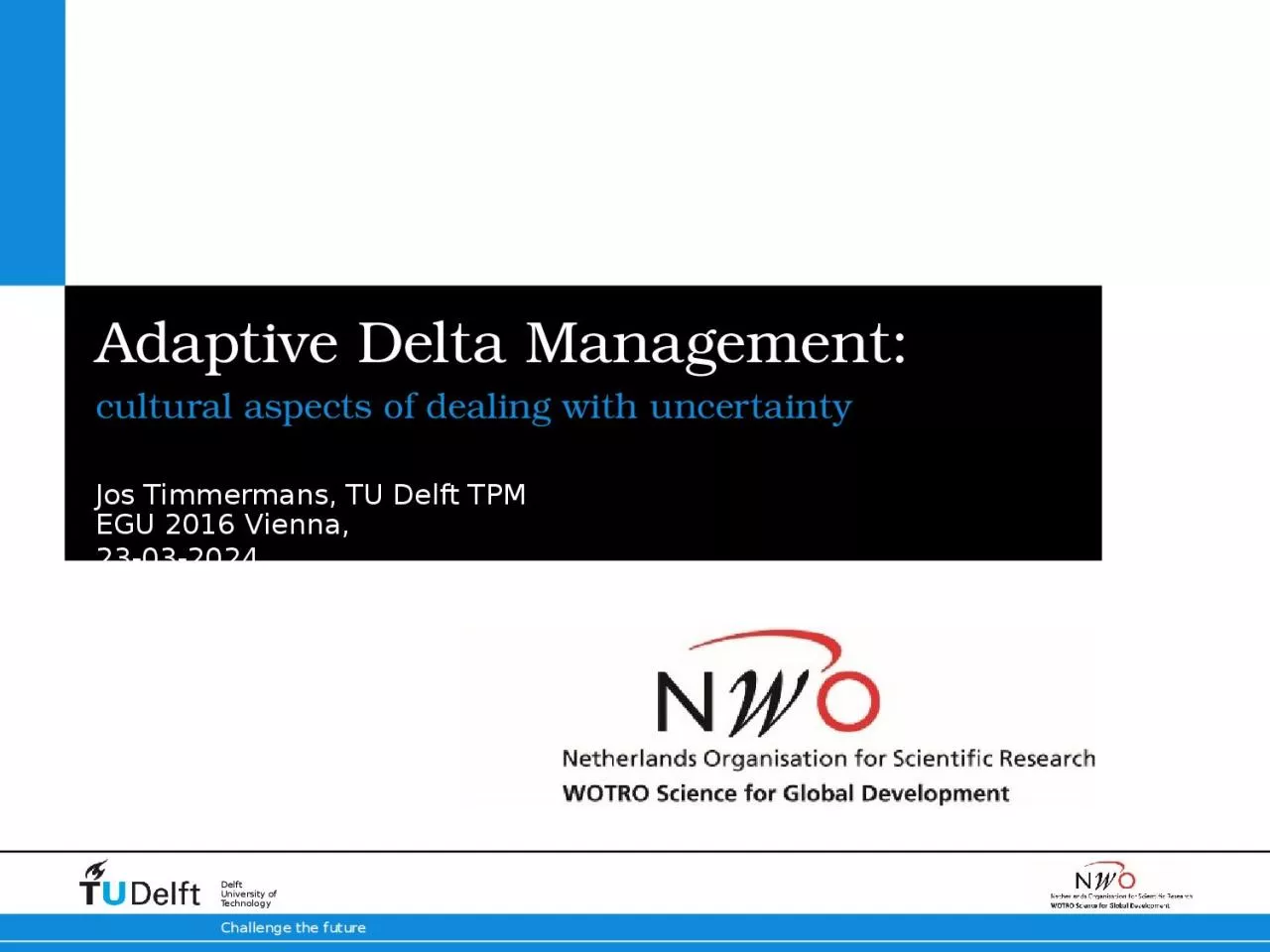

cultural aspects of dealing with uncertainty Jos Timmermans TU Delft TPM Introduction Deltas are highly dynamic physical erosion sedimentation subsidence social demographic economic trade ID: 1027199
Download Presentation The PPT/PDF document "Adaptive Delta Management:" is the property of its rightful owner. Permission is granted to download and print the materials on this web site for personal, non-commercial use only, and to display it on your personal computer provided you do not modify the materials and that you retain all copyright notices contained in the materials. By downloading content from our website, you accept the terms of this agreement.
1. Adaptive Delta Management:cultural aspects of dealing with uncertaintyJos Timmermans, TU Delft TPM
2. IntroductionDeltas are highly dynamicphysical (erosion, sedimentation, subsidence)social (demographic)economic (trade)infrastructures (transport, energy, metropolization)cultural (multi-ethnic)Deltas require multi-issue adaptation (climate & socio-economic) “This warrants the emergence of a branch of applied adaptation science, ADM, that is multi-issue and multi-faceted” Adaptive Delta Management is globalising (Bangladesh, Myanmar, Vietnam, ?)
3. Adaptive Delta Management‘Adaptive policy making applied to deltas’Walker, W. E., Rahman, S. A., & Cave, J. (2001). Adaptive policies, policy analysis, and policy-making. European journal of operational Research, 128(2), 282-289.Basic policyAdaptive actions
4. Dynamic Adaptive Policy PathwaysHaasnoot, M., Kwakkel, J. H., Walker, W. E., & ter Maat, J. (2013). Dynamic adaptive policy pathways: A method for crafting robust decisions for a deeply uncertain world. Global environmental change, 23(2), 485-498.
5. Combining ADM approaches and cultural characteristicsADM roots and branchesscientific rootsprofessional branchescharacteristic dimensionsmethodologyNational culturescharacteristic dimensionsMatching cultures and approachespreliminary assessmentmethodological issues
6. ADM Roots and Branches: overviewAdaptive Policy Making (Walker, 2001)Delta Program 2011SciencePracticeProfessionalBD Delta PlanUS DeltasTransition ManagementStrategic ManagementScienceDelta AllianceDeltares (Building with nature )BD Delta PlanDeltaresDAPPAdaptive ManagementPolicyAnalysisChange agentsManagementLearningAnalysis
7. Cultural dimensions (Hofstede, 1983)Power Distance: acceptance of inequality among its membersIndividualism: the importance of the individual versus the groupMasculinity: the relative dominance of female or male valuesUncertainty Avoidance: collective tolerance for ambiguityLong-term orientation: relative importance of a long-term and traditional view of time (dynamic, future-oriented vs. static, tradition-oriented)
8. Cultural dimensions: some quotesPower Distance: people demand justification for inequalities of powerIndividualism: self-image is defined in terms of “I” or “we”Masculinity: "tough versus tender"Uncertainty Avoidance: should we try to control the future or just let it happen? Long-term orientation: viewing societal change with suspicion or not
9. Cultural profiles of 4 deltas
10. Combining cultural and ADM dimensionsMethodological issue: how to test these hypothesis?
11. Suitability of ADM approaches for 4 deltas
12. ?
13. Power Distance Index (PDI) This dimension expresses the degree to which the less powerful members of a society accept and expect that power is distributed unequally. The fundamental issue here is how a society handles inequalities among people. People in societies exhibiting a large degree of Power Distance accept a hierarchical order in which everybody has a place and which needs no further justification. In societies with low Power Distance, people strive to equalise the distribution of power and demand justification for inequalities of power
14. Individualism versus Collectivism (IDV) The high side of this dimension, called individualism, can be defined as a preference for a loosely-knit social framework in which individuals are expected to take care of only themselves and their immediate families. Its opposite, collectivism, represents a preference for a tightly-knit framework in society in which individuals can expect their relatives or members of a particular in-group to look after them in exchange for unquestioning loyalty. A society's position on this dimension is reflected in whether people’s self-image is defined in terms of “I” or “we”
15. Masculinity versus Femininity (MAS)The Masculinity side of this dimension represents a preference in society for achievement, heroism, assertiveness and material rewards for success. Society at large is more competitive. Its opposite, femininity, stands for a preference for cooperation, modesty, caring for the weak and quality of life. Society at large is more consensus-oriented. In the business context Masculinity versus Femininity is sometimes also related to as "tough versus tender" cultures.
16. Uncertainty Avoidance Index (UAI)The Uncertainty Avoidance dimension expresses the degree to which the members of a society feel uncomfortable with uncertainty and ambiguity. The fundamental issue here is how a society deals with the fact that the future can never be known: should we try to control the future or just let it happen? Countries exhibiting strong UAI maintain rigid codes of belief and behaviour and are intolerant of unorthodox behaviour and ideas. Weak UAI societies maintain a more relaxed attitude in which practice counts more than principles.
17. Long Term OrientationEvery society has to maintain some links with its own past while dealing with the challenges of the present and the future. Societies prioritize these two existential goals differently.Societies who score low on this dimension, for example, prefer to maintain time-honoured traditions and norms while viewing societal change with suspicion. Those with a culture which scores high, on the other hand, take a more pragmatic approach: they encourage thrift and efforts in modern education as a way to prepare for the future.In the business context this dimension is related to as "(short term) normative versus (long term) pragmatic" (PRA). In the academic environment the terminology Monumentalism versus Flexhumility is sometimes also used.
18. Characteristic dimensions ADM rootsvalues vs preferencesorientation on the futuredecision makingMethodological issueCitation communities and topic model
19. Values versus preferencesvaluespreferences++resilienceSustainability visionManagement objectivesIntended strategyDefinition of success
20. Orientation on the futureanticipationvision++
21. Decision makingprocess orientationunicentricpolycentric